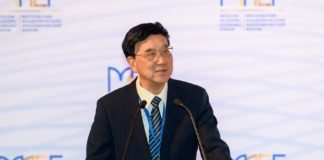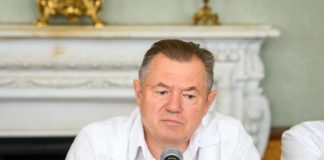On April 4-5, 2024, the IX St. Petersburg Economic Congress (SPEC-2024) was held, the theme of which this year was Prospective integration processes in the world economy: the noo-approach. The forum was organized by the New Industrial Development Institute named after. S.Yu. Witte with the participation of the Free Economic Society of Russia (VEO of Russia) and the International Union of Economists (IUE). Scientists and experts from Russia, Great Britain, the USA, China, India, Turkey, Belarus and other countries took part in the Congress.
Opening the plenary session, Director of the INIR named after. S.Yu. Witte, President of the VEO of Russia, Corresponding Member of the Russian Academy of Sciences Sergei Bodrunov named the goals and objectives of the Congress. “The IX St. Petersburg Economic Congress is dedicated to the study of global transformations of the social structure. The emphasis is on studying the problems of integration, its role and significance in the process of global transformations. The observed widespread strengthening of integration processes suggests that this phenomenon is becoming one of the important factors influencing the development of the world economy and, in fact, the world economic space as a whole,” noted the President of the Congress.
EURASIAN ECONOMIC INTEGRATION
The Eurasian Economic Union is an example of a new type of integration, believes Sergei Glazyev, Vice-President of the VEO of Russia, Vice-President of the IUE, Minister for Integration and Macroeconomics of the Eurasian Economic Commission, Academician of the Russian Academy of Sciences. “The Eurasian Economic Union, as an example of a new type of integration, is built on respect for the sovereignty of the member countries of the association, on voluntariness, mutual benefit, and on the consensus principle of decision-making. Since we recognize national sovereignty, we cannot force countries to delegate sovereign functions to a supranational body,” the scientist explained. At the end of 2023, the growth of the total GDP of the EAEU reached 3.7%. Economic growth is projected to be 2.5% in 2024. Sergei Glazyev is convinced that this forecast is underestimated: there are opportunities to maintain growth at the level of 3-5%. The scientist listed the possible leverages for accelerating the economic growth of the EAEU: He believes capital outflow should be stopped, innovation activity and labor productivity should be increased, and free production capacity should be used. “First, Since 2010, about 800 billion dollars have been exported from our countries. If these capitals remained in our economic space, the volume of investments could be increased by one and a half times. Second is low innovative activity. Calculations by the Institute of Economic Forecasting of the Russian Academy of Sciences show that we could achieve an increase in growth rates by 1-3% by enhancing scientific and technical potential. Third, low capacity utilization, which makes it possible to increase industrial output by one and a half times. Fourth, there is a labor reserve of about 4 million people in the EAEU. These are huge opportunities for increasing labor productivity,” says Sergei Glazyev.
Also, according to the scientist, it is necessary to develop cooperation between the EAEU and the countries of Southeast Asia, which is becoming a new center of the world economy — the core of the noo-integral and noo-technological structure. Member of the Presidium of the VEO of Russia, Deputy President of the Russian Academy of Sciences, Corresponding Member of the Russian Academy of Sciences Vladimir Ivanov named the priority areas of scientific and technological development of the EAEU. Among them are the development of a unified program of fundamental scientific research and the formation of a unified educational space. “First, we need to create a unified program of fundamental scientific research. This will not require additional funding, because all countries, one way or another, invest in fundamental science. The point is to correctly build a system of relationships within the framework of implementing priorities. Secondly, it is necessary to ensure the integration of the educational systems of Russia and the EAEU with a focus on achieving technological sovereignty and technological leadership. It is important to accept the declaration of the EAEU member countries on the formation of a single scientific and technological innovative educational space and to develop appropriate strategic planning documents,” said Vladimir Ivanov.
EURASIAN ECONOMIC UNION AND CHINA: PROSPECTS FOR INTEGRATION
The key areas for developing and deepening interaction between the Eurasian Economic Union and China within the framework of the One Belt, One Road initiative are infrastructure, in particular, port construction, finance, trade, energy, green and digital economy, the IUE member believes, co-chairman of the Expert Business Council of IUE and VEO of Russia on the development of Russian-Chinese cooperation, executive dean of the Chongyang Institute of Financial Studies of the People’s University of China, Professor Wang Wen. “If we talk about financial cooperation, China has agreed with Russia, Kazakhstan and Kyrgyzstan to conduct mutual payments in national currencies. In 2023 they rose to 80%. This is very important from the point of view of de-dollarization of economic ties between our countries. Regarding economic cooperation, China is developing its industrial parks in the EAEU. Thus, a large industrial park has been created in Belarus, which includes more than 40 companies, investments have already exceeded $1.1 billion. Our countries have signed many agreements and memorandums of understanding, for example, in the field of transport of goods and vehicles. We cooperate closely in terms of supplies of crude oil and gas. Bilateral trade is growing. We believe that within 3-5 years Russia will become China’s second trading partner after the United States,” the scientist noted.
According to Professor Wang Wen, it is necessary to develop cooperation between the EAEU and China as part of the implementation of the “One Belt, One Road” initiative based on four principles. The first is mutually beneficial cooperation. The second is openness and inclusiveness. The third is the development of market operations. The fourth is a high level of policy coordination.
Russia should deepen integration with China, RAS academician Abel Aganbegyan agreed. “Now this is mainly foreign trade, and on our part it is very backward in structure. There is no investment integration. China, which has gold and foreign exchange reserves of $3.5 trillion, does not invest in Russia. There is virtually no technology integration. China imports technological goods to Russia, but this is not enough. Chinese organizations could build roads, bridges, and housing in Russia, as they do in other countries. There is also no integration in the field of education. Russia should develop integration with China not only in the field of foreign trade, but also in other areas,” the scientist noted. According to the RAS academician, Russia should also develop cooperation with India in the field of infrastructure projects and IT technologies, as well as with Turkey, Saudi Arabia and the UAE.



